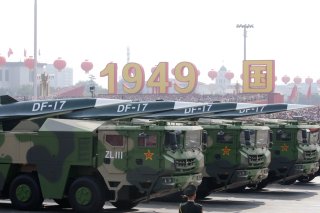The U.S. Needs to Go Hypersonic in Developing Hypersonic Weapons
China’s recent hypersonic test was perceived as a sign that it could soon surpass America’s military capability.
The United States has fallen behind in the development of hypersonic weapons, and it is a race it cannot afford to lose. China, Russia, and even North Korea have each conducted—or at least claimed to have conducted—hypersonic missile tests. The U.S. military suffered two catastrophic test failures last year, but Secretary of Defense Lloyd Austin has committed to pushing the nation's top defense contractors to speed up their development of hypersonic weapons.
The Pentagon will hold a virtual meeting that aims to "light a fire underneath the entire hypersonic industry," executives from at least two of the dozen defense contractors told reporters. Among the companies invited to attend are Boeing, Raytheon, and Northrop Grumman.
Secretary Austin's meeting will reportedly focus on the Department of Defense's concerns about getting these programs to the development stage, as well as lowering the associated cost. The technology, which includes aircraft, missiles, and rockets that can reach speeds through the atmosphere in excess of Mach 5—which is near 4,000 miles per hour—has been seen as a potential game changer for any military power that is able to develop it. Such weapons, which can also maneuver in flight, could be extremely difficult to counter.
A Major Investment
In addition to the threat that hypersonic weapons pose to the security of the United States, there is also the cost of the program. According to a report from international data analytics firm GlobalData, the sector could receive significant investment. The report estimates that the market is projected to grow to $49 billion by 2030.
"Interest and perceived viability of hypersonics have waxed and waned over the years, however now the technologies are advancing at a significant pace. The resurgence of great power competition between China, Russia, and the US has resulted in increased investment and interest by all parties," said William Davies, associate defense analyst at GlobalData.
Hypersonics have already been a source of significant funding for U.S. defense prime contractors in recent years, with Lockheed Martin estimating that it will earn $3 billion in value per year from hypersonic programs by 2026. Defense contractors are keen to continue scoring high-value contracts, according to GlobalData.
In addition, the 2022 National Defense Authorization Act approved $2.5 billion for hypersonic programs. However, as the actual price tag to produce the weapons comes into focus, tougher questions will be asked about the utility of the missiles in comparison to conventional weapons.
"A perception that the U.S. is falling behind adversaries is fueling a push to advance quicker than planned," Davies explained. "The high cost of the programs is also a concern, though the weapons are likely to come down in cost once they reach the production phase. The cancellation of the Hacksaw (HCSW) program in 2018 shows that these technologies are not safe from budget cuts and industry leaders will be keen to show that their programs are approaching viability."
U.S. hypersonic programs are planned to reach the production stage in 2022, with the U.S. Air Force's Air Launched Rapid Response Weapon (ARRW) program being the most advanced program. The ARRW program is a boost-glide weapon produced by Lockheed Martin, and despite testing failures, the company is still committed to producing at least a dozen by the end of 2022.
It was last October, after the Chinese military tested a nuclear-capable hypersonic missile, that warning bells truly sounded. China’s test was perceived as a sign that China could soon surpass America’s military capability.
"I don't know if it's quite a Sputnik moment," Gen. Mark Milley, chairman of the Joint Chiefs of Staff, told lawmakers at the time. "But I think it's very close to that."
Peter Suciu is a Michigan-based writer who has contributed to more than four dozen magazines, newspapers and websites. He regularly writes about military small arms, and is the author of several books on military headgear including A Gallery of Military Headdress, which is available on Amazon.com.
Image: Reuters

